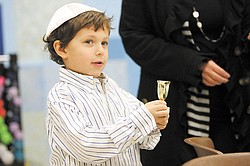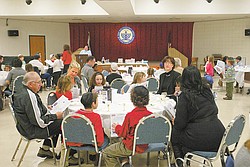Students learn about Seder
By LINDA M. LINONIS
linonis@vindy.com
YOUNGSTOWN
Dylan Shapiro, 5, holds a cup of grape juice, which is part of the order of the Seder. The ritual meal, which took place for Akiva Academy students, involves drinking four cups of grape juice or wine, which symbolize four of God’s promises of freedom to the Jewish people. Wine is a symbol of joy.
Students of Akiva Academy in Youngstown and teachers and family members gather for a model Seder 2at the Jewish Community Center. Susan Schonberger led the ritual meal for Passover.
Susan Schonberger fulfilled a goal of the Seder — telling children the story about the exodus, the liberation of the Israelites from slavery in ancient Egypt.
She led kindergarten- through sixth-grade students from Akiva Academy through the order of the Passover Seder during a recent model meal at the Jewish Community Center.
The passage from Exodus in the second book of the Torah, “You shall tell your child on that day, ‘It is because of what the Lord did for me when I came out of Egypt.’”
Passover began at sundown Monday with family gatherings.
Today, second Seders in the form of community meals will take place at local synagogues.
“This is a reflection of what a home ritual would be,” said Schonberger, the director of Judaic studies at Akiva, of the Seder.
The theological aspect of the observance isn’t emphasized. “That’s not our purpose here,” she said.
The 61 students at Akiva come from a variety of faiths, including Judaism.
Schonberger also noted that the order of the Seder — drinking, washing hands, eating symbolic foods including matzah, telling the Passover story, saying blessings and singing — have certain places in the ritual meal.
Schonberger said it is a “religious duty to tell the story of the exodus from Egypt” and to tell the story “from generation to generation.”
At the children’s Seder, the story was conveyed in English and Hebrew.
Schonberger said the school Seder helps the children understand what is going on at the family events.
“Every Jewish family has their own traditions,” she said. But, she emphasized, the idea of freedom is something everyone can understand.
Sampling the traditional items on the Seder plate becomes a kind of history and social-studies lesson because students learn about the exodus of the Israelites from Egyptian bondage and what the foods signify.
The ritual engages children because it involves lighting candles, singing songs and answering questions.
Drinking four glasses of grape juice at the Seder teaches the children about the four passages in Exodus in which God promises to deliver the Israelites.
“Wine is a sign of happiness and joy," Schonberger said.
But when participants drink for the second time, glasses should not be completely full to indicate that happiness is not complete.
Even though the Israelites were glad to be free, they know others are not.
Abigail Scharf, 9, of Boardman, a fourth-grader, said her favorite part of the Seder involves the four children — one wise, one contrary, one simple and the one “who does not know how to ask.”
During the Seder, each comments on the meaning of the service. She also said singing the songs was fun.
Lulu Herman, 6, of Liberty, a first-grader, said she liked the matzah.
The Passover Seder, a Jewish ritual feast, marks the beginning of Passover. The ritual includes retelling of the story from Exodus about the Israelites’ liberation from slavery in ancient Egypt. Customs include drinking four cups of wine or grape juice, which symbolize four promises made by God to the Jews; eating matzah, unleavened bread that symbolizes the Israelites’ rush to leave, hence they didn’t let bread dough rise; and symbolic foods on the Seder plate. Symbolic foods are:
Maror: Bitter herbs such as horseradish and romaine lettuce are symbolic of the bitterness of slavery in Egypt.
Harosef or charoset: A sweet, sticky mixture of apples, nuts, dates and wine, symbolic of the clay the Israelites used to make bricks for the pharaoh.
Z’roa: Roasted bone of the sacrificial lamb brought to the temple in Jerusalem as an offering to God.
Karpas: Fresh vegetable such as parsley, celery or potato to remind participants that Passover occurs in the spring, a time of new life. It is dipped in saltwater, vinegar or lemon juice to symbolize the tears shed by Israelite slaves.
Beitsa: Roasted (hard-boiled) egg is symbolic of an offering brought to the temple in honor of a holiday.
Matzah or matza: Three crackers remind participants of three kinds of people — those who are not yet free, those who don’t care about the freedom of others and those who are free and work to help others become free.
Hazeret: This additional bitter vegetable is used for the korech sandwich of matzah and maror.
Yayin: Four cups of wine or grape juice to remind participants of four of God’s promises of freedom to the Jewish people.
 43
43


